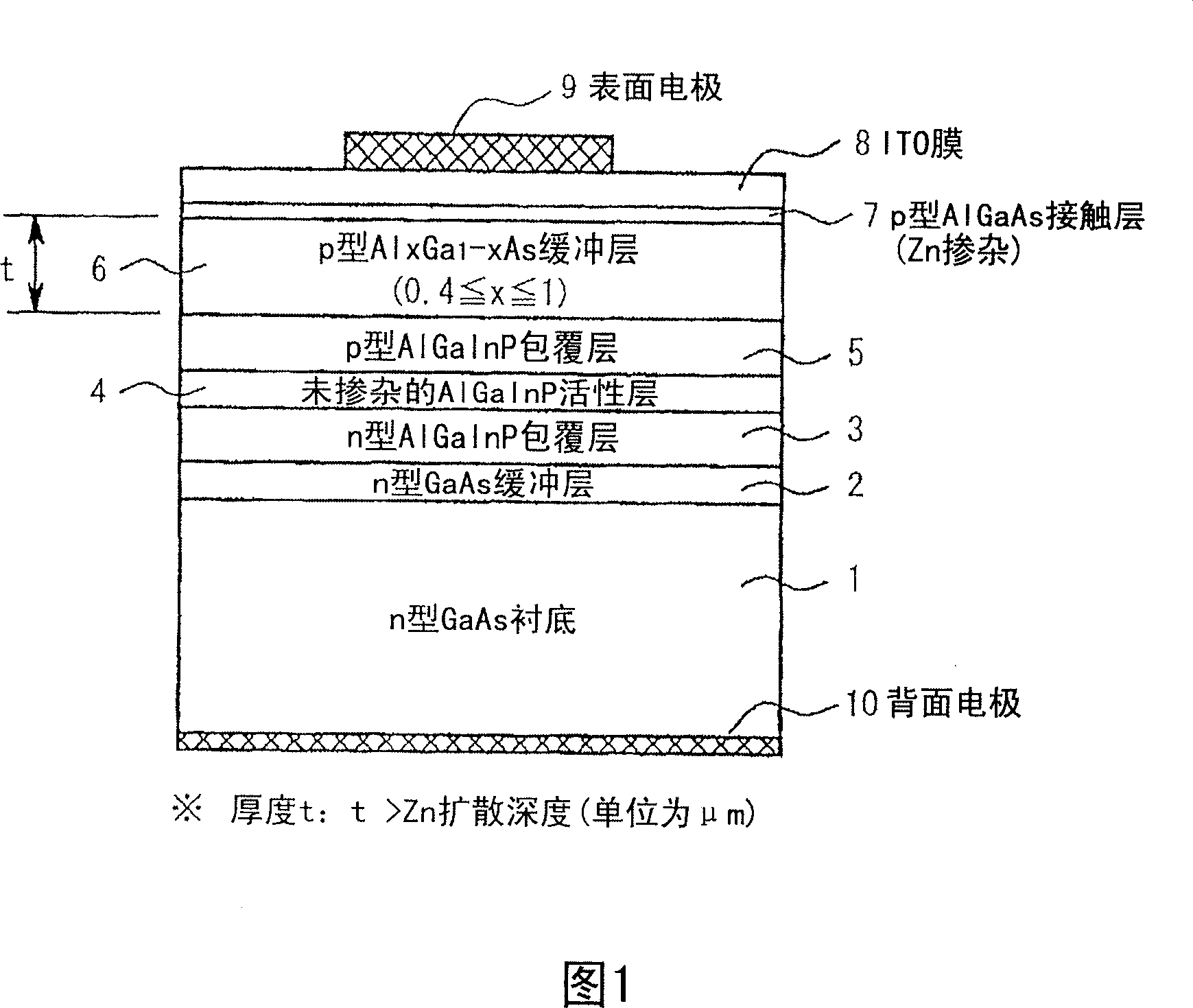Semiconductor light-emitting device
A technology of light-emitting elements and semiconductors, applied in semiconductor devices, electrical components, circuits, etc., can solve problems such as reduced component life, increased tunnel voltage, and dopant diffusion
- Summary
- Abstract
- Description
- Claims
- Application Information
AI Technical Summary
Problems solved by technology
Method used
Image
Examples
no. 1 approach
[0081] FIG. 1 is a cross-sectional view showing an AlGaInP-based red LED according to a first preferred embodiment of the present invention.
[0082] The LED comprises the following layers formed sequentially on an n-type GaAs substrate 1 as a semiconductor substrate: n-type GaAs buffer layer 2, n-type AlGaInP cladding layer 3 (abbreviated as n-type cladding layer), undoped The AlGaInP active layer 4 (referred to as the active layer for short), and the p-type AlGaInP cladding layer 5 (referred to as the p-type cladding layer for short), wherein, 3-5 layers are epitaxially grown to form the light emitting part. Furthermore, an As-based p-type AlGaAs contact layer 7 (abbreviated as a p-type contact layer) to which a p-type dopant is added at a high concentration is formed on the p-type cladding layer 5 . On the p-type contact layer 7, an ITO film 8 (current spreading layer) as a transparent conductive film is formed as a current spreading layer made of a metal oxide, and a surfa...
Embodiment 1
[0123] In Example 1, an epitaxial growth wafer for a red LED having an emission wavelength around 630 nm and having the structure shown in FIG. 1 was produced. The growth method of the epitaxial growth, the film thickness of the epitaxial growth layer, the structure of the epitaxial layer, the formation method of the electrode, and the manufacturing method of the LED element are as follows.
[0124] Using the MOVPE method, on the n-type GaAs substrate 1 with Si as the dopant, the layers are sequentially grown: n-type (Si-doped) GaAs buffer layer 2 (film thickness 200nm, carrier concentration 1×10 18 / cm 3 ), n-type (Si-doped) (Al 0.7 Ga 0.3 ) 0.5 In 0.5 P cladding layer 3 (film thickness 400nm, carrier concentration 1×10 18 / cm 3 ), undoped (Al0.1 Ga 0.9 ) 0.5 In 0.5 P active layer 4 (film thickness 600nm), p-type (Mg-doped) (Al 0.7 Ga 0.3 ) 0.5 In 0.5 P cladding layer 5 (film thickness 400nm, carrier concentration 1.2×10 18 / cm 3 ), p-type (Mg-doped) (Al 0.85 ...
Embodiment 2
[0141] In Example 2, an epitaxial growth wafer for a red LED having an emission wavelength around 630 nm and having the structure shown in FIG. 3 was produced. The growth method of the epitaxial growth, the film thickness of the epitaxial growth layer, the structure of the epitaxial layer, the method of forming the electrodes, and the manufacturing method of the LED element are basically the same as those of the above-mentioned Example 1 (FIG. 1). Differences from Example 1 are enumerated below and described in detail.
[0142] In Example 2, a diffusion preventing layer 11 is provided between the active layer 4 and the p-type cladding layer 5, and this layer is a semiconductor layer not positively added, that is, a so-called undoped layer. The diffusion prevention layer 11 prevents the p-type dopant diffused from the p-type semiconductor layer including the above-mentioned p-type cladding layer 5 and the upper layer from being mixed into the active layer 4 . The composition o...
PUM
 Login to View More
Login to View More Abstract
Description
Claims
Application Information
 Login to View More
Login to View More - Generate Ideas
- Intellectual Property
- Life Sciences
- Materials
- Tech Scout
- Unparalleled Data Quality
- Higher Quality Content
- 60% Fewer Hallucinations
Browse by: Latest US Patents, China's latest patents, Technical Efficacy Thesaurus, Application Domain, Technology Topic, Popular Technical Reports.
© 2025 PatSnap. All rights reserved.Legal|Privacy policy|Modern Slavery Act Transparency Statement|Sitemap|About US| Contact US: help@patsnap.com



